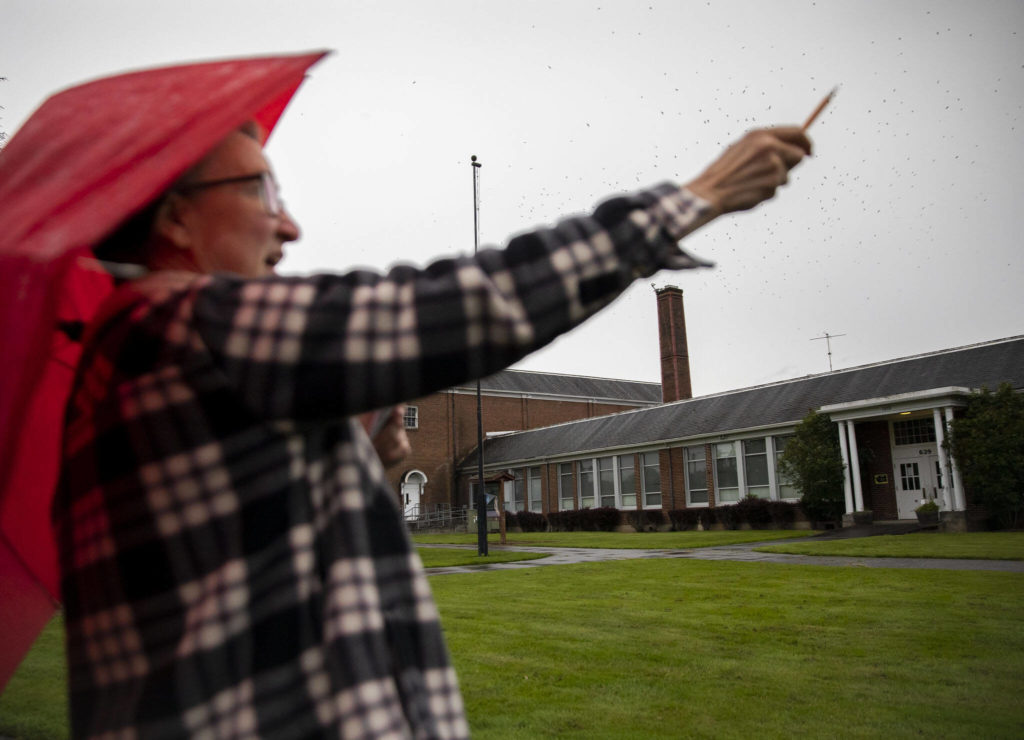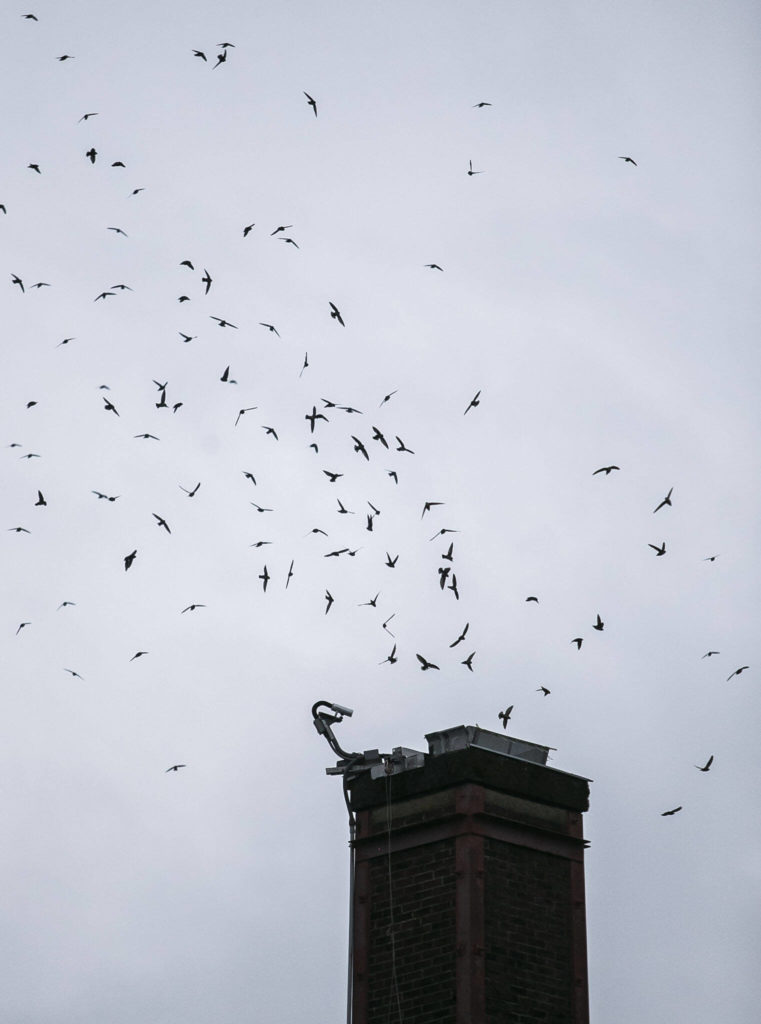MONROE — Monroe’s famously fast birds are back. Vaux’s swifts are pulsating and twirling above their favorite brick chimney on Main Street, an iconic pit stop on their international migration.
The flock has been in the spotlight for years.
But shift your gaze downward to meet the birders tasked with tallying these speedy swifts. Unlike their favorite birds, the counters are silent and statue-still. These dedicated birders love swifts so much, said volunteer Judy Alles, that bird poop on their raincoats is a sort of “badge of honor.”
Last week, it was Cathy Clark’s turn.
Standing outside Frank Wagner Elementary School with scrap paper, a pencil and tattered umbrella, she kept a keen eye on the chimney.
The key is to catch the moment they collectively decide it’s bedtime. Heeding some secret signal, the chimney seems to suck down thousands of birds.
“Some of them don’t want to go in yet, because they don’t want to be on the bottom of the stack,” Clark said. “Like Dr. Seuss, ‘Yertle the Turtle.’”
The birds are physically unable to perch upright or walk. Inside the chimney, they cling to the vertical wall — or to the backs of their flock mates — tucking tails under heads like Legos clicked together.
They make sure to poop before they go inside, Alles said.
“Nature’s just so amazing.”
For over a decade, Alles has organized the twice-yearly, 10-week counts. Volunteers come from as far as Stanwood and Edmonds to help.
The hope is to use the data for conservation.
Since local birders saved the chimney from demolition and started counting the birds, this communal roost has been formally recognized as an “important bird area,” or IBA. It’s lumped together with three other chimneys across the state as part of a “chimney corridor” for Vaux’s swifts.
Before chimneys and deforestation, the species clung to Douglas fir trees.
Clark has been a reliable counter for years, Alles said, “just like the sun going up and back down again.”
Clark’s been involved with the Audubon Society for decades. Her wildlife experience extends to other winged creatures, too. She has reared monarch butterflies in an attempt to establish a Western Washington population. And this year she helped discover a new species: the Asher’s blue. It’s a dreamy, lavender-colored butterfly.
“It’s now big, big news in the butterfly world,” she said. “So my little footnote to science moved up to the introduction. I’m feeling pretty proud of myself.”
But it seems Clark’s heart has been truly captured by Vaux’s swifts. When she describes the crows that used to perch on the chimney, picking out tasty swifts “like fish in a barrel,” her smile turns to a frown.
“They’re my babies,” she said.
(Volunteers have since installed anti-predator barbed wire atop the chimney.)
Alles has a similar affinity for the swifts.
These days, she checks her phone throughout the day to see a live stream from within the chimney.
“I can’t resist. I want to know who’s in there,” she said. “They’re so cute.”
Alles recalls her very first migration season, 14 years ago. The 21,000 swifts she counted in a single night far exceeded expectations.
“My ankles were frozen,” she remembered. “After about two hours I said, ‘Please, dear Lord, get them in the chimney. Stop them. There’s just too many. I don’t think I can walk.”
Alles described the birds bubbling back out of their roost like the scarab beetles in “The Mummy.”
A few years back, Clark and Alles helped release a few orphaned swifts back into the fall flock. They were rehabilitated over the summer, clinging to blankets hanging in a shower stall and “stuffing mealworms down until they were fatter than could be,” Clark recalled.
“Not only had they never flown,” Alles said, “they had never flown into a chimney, and we were so afraid.”
But the flock quickly took the youngsters under their many flapping wings. It’s that social, kind-hearted quality that Alles loves about the species.
By sunset, Clark tallied over 14,000 birds.
She’ll be here for a few more weeks, until the stream of swifts makes it back from the tropics. The birds will hang around for the summer, building nests out of twigs and spit in old hollow trees.
Then, as temperatures drop, the flock will return to Monroe. So will Clark.
“Tuesday. That’s my day,” she said. “Start back up in the fall and do it all over again.”
Want to see the swifts?
The Vaux’s swifts’ spring migration winds down in mid-June, when most of them have made their way back to the Pacific Northwest. Until then, find the flock above Frank Wagner Elementary in Monroe. The birds usually arrive in the evening and begin their enchanting descent around sunset.
If the weather sours, you may want a rain check — the swifts generally retreat into the chimney if it’s too wet.
Even in sunny weather, the migration is unpredictable. Volunteers have tallied nightly numbers as high as 21,000 and as low as 0.
The species breeds in our area over the summer. You can spot them in small numbers as they raise their young.
They generally return in huge numbers in mid-August and into September, when they start flying back to Mexico and other warmer wintering grounds.
Claudia Yaw: 425-339-3449; claudia.yaw@heraldnet.com; Twitter: @yawclaudia.
Talk to us
> Give us your news tips.
> Send us a letter to the editor.
> More Herald contact information.





























